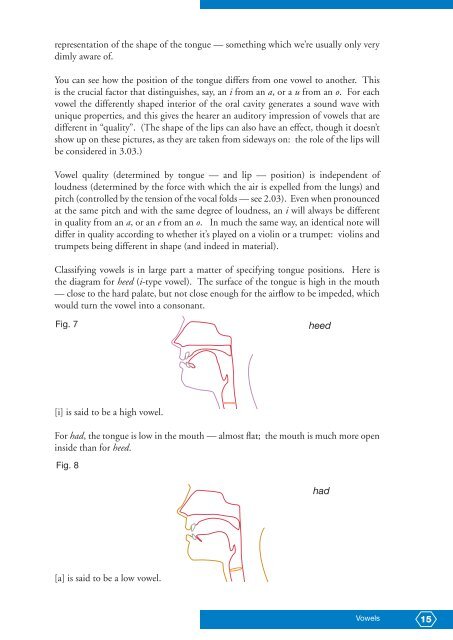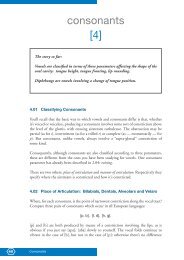PHONETICS MANUAL.indd - HumBox
PHONETICS MANUAL.indd - HumBox
PHONETICS MANUAL.indd - HumBox
You also want an ePaper? Increase the reach of your titles
YUMPU automatically turns print PDFs into web optimized ePapers that Google loves.
epresentation of the shape of the tongue — something which we’re usually only very<br />
dimly aware of.<br />
You can see how the position of the tongue differs from one vowel to another. This<br />
is the crucial factor that distinguishes, say, an i from an a, or a u from an o. For each<br />
vowel the differently shaped interior of the oral cavity generates a sound wave with<br />
unique properties, and this gives the hearer an auditory impression of vowels that are<br />
different in “quality”. (The shape of the lips can also have an effect, though it doesn’t<br />
show up on these pictures, as they are taken from sideways on: the role of the lips will<br />
be considered in 3.03.)<br />
Vowel quality (determined by tongue — and lip — position) is independent of<br />
loudness (determined by the force with which the air is expelled from the lungs) and<br />
pitch (controlled by the tension of the vocal folds — see 2.03). Even when pronounced<br />
at the same pitch and with the same degree of loudness, an i will always be different<br />
in quality from an a, or an e from an o. In much the same way, an identical note will<br />
differ in quality according to whether it’s played on a violin or a trumpet: violins and<br />
trumpets being different in shape (and indeed in material).<br />
Classifying vowels is in large part a matter of specifying tongue positions. Here is<br />
the diagram for heed (i-type vowel). The surface of the tongue is high in the mouth<br />
— close to the hard palate, but not close enough for the airflow to be impeded, which<br />
would turn the vowel into a consonant.<br />
Fig. 7<br />
heed<br />
[i] is said to be a high vowel.<br />
For had, the tongue is low in the mouth — almost flat; the mouth is much more open<br />
inside than for heed.<br />
Fig. 8<br />
had<br />
[a] is said to be a low vowel.<br />
Vowels<br />
15






